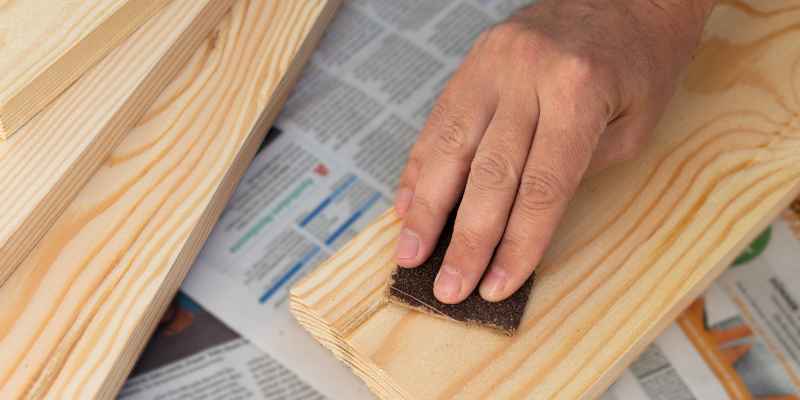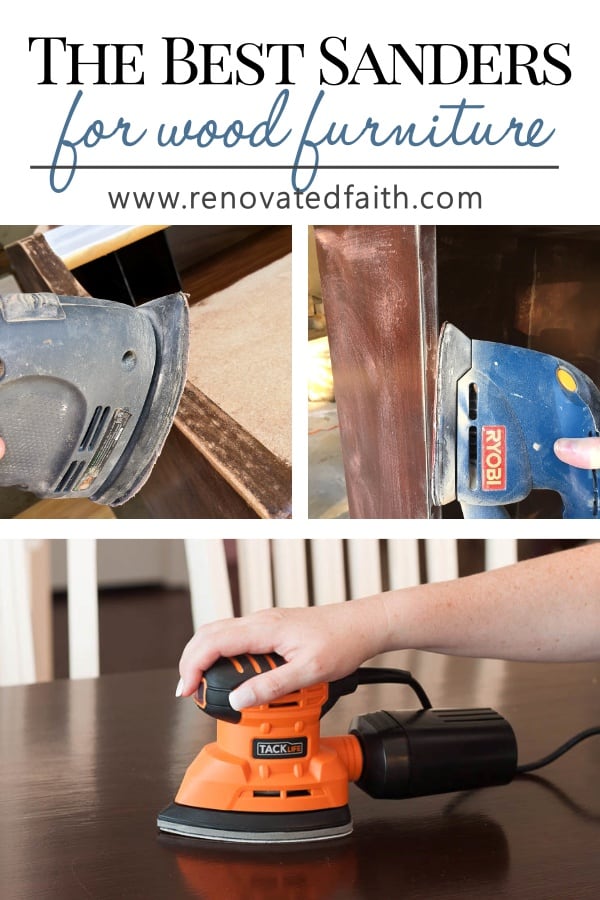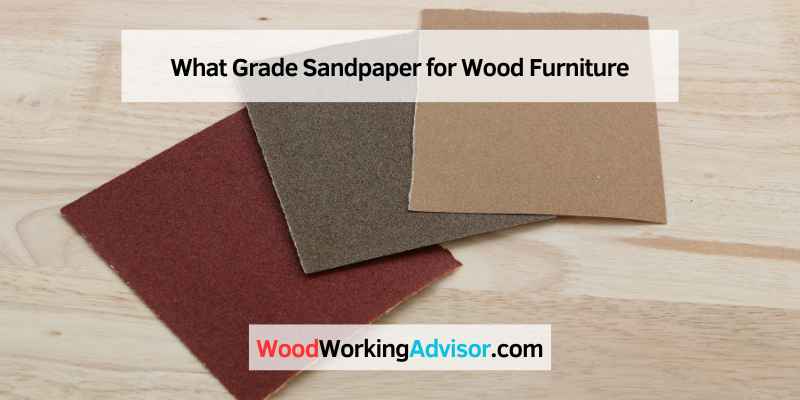The answer may surprise you if you’re wondering what grade sandpaper to use for wood furniture. You don’t necessarily need to break out the heavy-duty grits to get a smooth finish. Using too high of determination can damage the wood.
Choosing the Right Grade Sandpaper for Your Woodworking Project – Refinishing Furniture
If you’re wondering what grade sandpaper to use for wood furniture, the answer depends on the type of wood and the finish you’re hoping to achieve. For example, if you’re working with a soft wood like pine, you’ll want to start with a coarse grit like 60 or 80. But if you’re working with a more complicated wood like oak or maple, you might want to start with a finer grit like 100 or 120.
And if you’re hoping for a smooth finish, you might even go up to 220 grit. Ultimately, it’s essential to experiment and see what works best for your particular project. But once you find the proper sandpaper, you’ll be one step closer to achieving the perfect finish on your wood furniture!

What Grit Sandpaper for Wood Furniture Before Painting
If you’re painting wood furniture, you’ll want to start with rough-grit sandpaper. This will help to remove any existing paint or varnish from the surface of the wood so that your new paint job will have a smooth, even surface to work with. Once you’ve sanded down the furniture with rough grit sandpaper, you can switch to a finer grit paper to smooth out any remaining imperfections before starting to paint.
What Grit Sandpaper for Wood Table
To refinish a wood table, you’ll need to start with the right type of grit sandpaper. Otherwise, you could damage the table or take too much time sanding. So, what grit sandpaper should you use for a wood table?
The answer depends on the type of wood and the table‘s condition. If the wood is soft, like pine, you’ll want to start with a lower grit (60-80) to remove any existing finish and smooth any roughness. For harder woods, like oak, you can start with a higher determination (100-120) to avoid over-sanding.
If the table is in good condition and needs light sanding to prep for painting or staining, then starting with a higher grit will be fine. But if the table is in poor condition and has deep scratches or gouges, beginning with a lower determination will help remove those blemishes more quickly. No matter what type of wood or condition your table is in, always work your way up through the different grits until you reach 220.
This will ensure that your table has a smooth, even finish ready for whatever new look you’re going for!
What Grit Sandpaper for Wood Furniture before Staining
If you’re staining wood furniture, you’ll want to start with a fine-grit sandpaper. This will help to create a smooth surface for the stain to adhere to. You may also want to use a pre-stain conditioner before starting your project.
What Grit Sandpaper for Wood before Painting
If you’re painting wood, you’ll want to start with coarse grit sandpaper to remove any existing paint or finish. Once the surface is smooth, you can move on to finer grit sandpaper to prep the surface for painting. Be sure to sand in the same direction as the wood grain for the best results.
Sanding Furniture for Beginners
If you’re new to woodworking or refinishing furniture, sanding can seem daunting. But with the right tools and techniques, it’s pretty easy! This blog post will give you a step-by-step guide to sanding furniture for beginners.
The first step is to choose the right type of sandpaper. For most projects, we recommend using 120-grit sandpaper. This will remove any existing finishes on your piece of furniture and provide a smooth surface for painting or staining.
Next, attach your sandpaper to your sander. If you’re using an electric sander, read the manufacturer’s instructions before turning it on. Once your sander is ready to go, slowly move it back and forth across the surface of your furniture in long, even strokes.
As you work, keep an eye out for areas that need more attention than others. You may need to go over these areas with finer grit sandpaper (200-grit or higher) to get a completely smooth finish. Once you’ve finished sanding, vacuum up all the dust and wipe down the surface of your furniture with a damp cloth.
Then you’re ready to stain or paint!
How to Strip And Refinish Wood Furniture
Stripping and refinishing wood furniture is a great way to save money and get a custom look for your home.
Here are some tips on how to strip and refinish wood furniture:
- Start by removing all the hardware from the piece of furniture.
This includes any knobs, pulls, hinges, etc. Set these aside in a safe place, so you don’t lose them.
2. Next, use a paint stripper to remove the old finish from the furniture.
Follow the directions on the paint stripper carefully.
3. Once the old finish is removed, sand the furniture down until it is smooth. Be sure to use fine-grit sandpaper, so you don’t damage the wood.
4. Now, it’s time to apply a new finish to the furniture. You can either stain or paint the piece, depending on your preference. If you stain, be sure to follow all of the manufacturer’s instructions carefully.
If you paint, choose a high-quality paint that will hold up well over time.
5. Finally, reinstall all the hardware you removed in step one.
And that’s it!
What Grit Sandpaper to Strip Wood
If you’re looking to strip wood, the best type of grit sandpaper is 36-grit. This will remove any paint or varnish quickly and easily, leaving you with a clean surface. Just be sure to sand in the direction of the grain to avoid damaging the wood.

Credit: renovatedfaith.com
What Grit Sandpaper Should I Use before Painting Furniture?
If you’re painting furniture, you’ll want to start with gritty sandpaper to help remove any existing paint or varnish. A higher grit will give you a smoother finish, so if your furniture is already in good condition, you can start with finer sandpaper. Work your way up to a finer grit, so you don’t damage the wood.
What is the Best Sandpaper to Sand Wood?
There are many types of sandpaper, each designed for a different purpose. The kind field and the desired results determine the best sandpaper for sanding wood. For most projects, an all-purpose sandpaper will suffice.
These are typically made with aluminum oxide or silicon carbide particles and can be used on softwood and hardwood. If you’re working with a particularly hard or soft type of wood, you may need to use a different grade of sandpaper. For example, softer woods like cedar or pine may require a finer grit paper, while harder woods like oak or maple require a coarser grit.
The goal is to start with a lower grit number and work up to a higher one as you progress through the project. This will create progressively smoother results as you go. When sanding is time, always begin with light pressure and increase it as needed.
It would be best to keep the sander moving to avoid creating gouges on the wood surface. And finally, be sure to wipe away any excess dust after each pass to ensure better visibility and prevent clogging.
Is 120 Grit Sandpaper Good for Wood?
120-grit sandpaper is a good choice for woodworking projects. It is important to note that the lower the grit number, the more coarse the paper will be. For instance, 60-grit paper is more coarse than 120-grit paper.
That said, 120-grit sandpaper will remove materifasterkly than a higher-numbered grit. One advantage of using a lower numbered grit like 120 is that it can help to create a smooth surface. This can be especially helpful when working with softer woods or prepping a surface for painting or staining.
Another reason to use this particular type of sandpaper is if you are trying to remove old paint or varnish from a piece of wood furniture. Generally, starting with a lower-numbered grit is always best, then moving up as needed. This will help you avoid damaging your project and ensure that you finish the best possible.
What Grit Sandpaper Should I Use for a Dresser?
There are a few things to consider when deciding what grit sandpaper to use for a dresser. The type of wood, the finish, and the desired result all play a role in choosing the right sandpaper. For most woods, medium-grit sandpaper (60-80) is a good starting point.
If the wood is very soft or has an old finish that needs to be removed, you may need to start with coarse-grit sandpaper (40-60). And if you’re looking for a very smooth finish, you’ll want to use fine-grit sandpaper (100-120). Remember that the higher the grit number, the finer the sandpaper.
So if you’re unsure which grit to use, it’s better to err on the side of too coarse rather than too fine. You can always go back and re-sand with a finer grit if needed.
Conclusion
If you’re wondering what grade of sandpaper to use for wood furniture, the answer is: it depends. The type of wood and the finish you’re hoping to achieve will play a role in determining which sandpaper grit is best for your project. In general, start with a coarse grit (60-80) and then move to the finer grit (100-120) as needed.
With patience and a little trial and error, you’ll get the perfect finish for your beautiful furniture pieces.



15 thoughts on “What Grade Sandpaper for Wood Furniture”